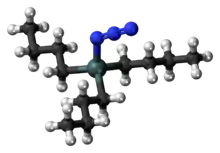Tributyltin azide
Tributyltin azide is an organotin compound with the formula (C4H9)3SnN3. It is a colorless solid although older samples can appear as yellow oils. The compound is used as a reagent in organic synthesis.
 | |
 | |
| Names | |
|---|---|
| IUPAC name
Azido(tributyl)stannane | |
| Other names
Tri-n-butylazidotin; Tributyltin azide; Azidotributyltin; Azidotributyltin(iv); Azidotributylstannane; Nsc179738 | |
| Identifiers | |
3D model (JSmol) |
|
| Abbreviations | TBSnA |
| ECHA InfoCard | 100.133.218 |
CompTox Dashboard (EPA) |
|
| |
| |
| Properties | |
| C12H27N3Sn | |
| Molar mass | 332.079 g·mol−1 |
| Appearance | Colorless to light yellow liquid or white solid |
| Density | 1.212 g/mL |
| Boiling point | 120 °C (248 °F; 393 K) at 0.2 mmHg |
| Reacts | |
| Hazards | |
| R-phrases (outdated) | R21 R23 R25 R36 R38 R48 R50 R53 |
| S-phrases (outdated) | S35 S36 S37 S39 S45 S60 S61 |
| Flash point | > 110 °C (230 °F; 383 K) |
| Lethal dose or concentration (LD, LC): | |
LD50 (median dose) |
400 mg/kg (oral, rat) |
Except where otherwise noted, data are given for materials in their standard state (at 25 °C [77 °F], 100 kPa). | |
| Infobox references | |
Synthesis and reactions
Tributyltin azide is synthesized by the salt metathesis reaction of tributyltin chloride and sodium azide.
It is a reagent used in the synthesis of tetrazoles, which in turn are used to generate angiotensin II receptor antagonists. In some applications, tributyltin azide has been replaced by the less toxic trioctyltin azide and organoaluminium azides.[1]
Safety
Lower alkyl tin compounds are often highly toxic and have penetrating odors. Tributyltin azide causes skin rashes, itching or blisters.[2][3]
References
- Aureggi, Valentina; Sedelmeier, Gottfried (2007). "1,3-Dipolar Cycloaddition: Click Chemistry for the Synthesis of 5-Substituted Tetrazoles from Organoaluminum Azides and Nitriles". Angewandte Chemie. 119 (44): 8592. doi:10.1002/ange.200701045.
- Tri-higher alkyl tin azide and its use, United States Patent 5484955
- Saito, S (1989). "Highly nucleophilic tributyltin azide in oxirane ring cleavage leading to 1,2-azido alcohol". Tetrahedron Letters. 30 (31): 4153–4156. doi:10.1016/S0040-4039(00)99346-8.
This article is issued from Wikipedia. The text is licensed under Creative Commons - Attribution - Sharealike. Additional terms may apply for the media files.